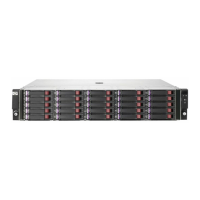Using the Embedded Web Server74
4. Set the fabric parameters:
a. At the R_A_TOV field, enter a value between 10 through 1200 tenths of a second (one
through 120 seconds). The default is 10 seconds (100 tenths).
All fabric-attached switches must be set to the same R_A_TOV. If the value is not compatible,
the E_Port connection to the switch segments and the switch cannot communicate with the
fabric. In addition, the R_A_TOV must be greater than the E_D_TOV.
b. At the E_D_TOV field, enter a value between 2 through 600 tenths of a second (0.2 through
60 seconds). The default is 20 tenths of a second (2 seconds).
All fabric-attached switches must be set to the same E_D_TOV. If the value is not compatible,
the E_Port connection to the switch segments and the switch cannot communicate with the
fabric. In addition, the E_D_TOV must be less than the R_A_TOV.
c. The switch priority value designates the fabric’s principal switch. The principal switch controls
the allocation and distribution of domain IDs for all fabric directors and switches (including
itself). At the Switch Priority field, select Principal, Never Principal, or Default (the default
setting is Default).
d. Select the Interop mode:
• McDATA Fabric 1.0. (default). Select this mode if the fabric contains only M-Series
switches that are operating in McDATA Fabric 1.0 mode.
• Open Fabric 1.0. Select this mode if the fabric contains HP directors and switches, as well
as other open fabric-compliant switches. Select this mode for managing heterogeneous
fabrics.
5. Click Activate to save the information. The message Your changes to the operating
parameters configuration have been successfully activated is displayed.
6. Set the switch online:
a. At the View window, select Operations at the left side of the panel. The Operations panel
opens with the Switch Beacon page displayed.
b. At the Operations panel, click the Online State tab, then click Set Online. The message Your
operations changes have been successfully activated is displayed.
Configure network information
Verify that the type of LAN installation with the customer’s network administrator. If one switch is
installed on a dedicated LAN, network information (IP address, subnet mask, and gateway address)
does not require change. Go to ”Configure switch ports” on page 68.
If multiple switches are installed, or a public LAN segment is used, network information must be
changed to conform to the customer’s LAN addressing scheme. Perform one of the following:
• If network information was changed while performing ”Configure switch network information”
on page 34, this procedure is not required. Go to ”Configure SNMP trap message recipients”
on page 76.
• If network information was not changed, perform the following steps to change a switch IP
address, subnet mask, or gateway address:
